
Floydia is a monotypic genus of plants in the macadamia family Proteaceae which is endemic to Australia. The sole described species is Floydia praealta, commonly known as the ball nut. It is a somewhat rare tree found only growing in the rainforests of southeastern Queensland and northeastern New South Wales. The tree has a superficial resemblance to the closely related Macadamia and could be confused with them. The fruit of F. praealta is poisonous.

Hymenosporum is a monotypic genus of trees in the family Pittosporaceae. The sole included species is Hymenosporum flavum, commonly known as native frangipani, found in the rainforests and wet sclerophyll forests of New Guinea, Queensland and New South Wales. Despite its common name, it is not closely related to the frangipani, but is related to the widespread genus Pittosporum.

I. M. Johnston, was a United States botanist. He studied at Pomona College in Claremont, California and at Harvard University. His plant collections are housed in the Rancho Santa Ana Botanic Garden, in Claremont, and also in the Gray Herbarium of Harvard University.

Atractocarpus fitzalanii, commonly known as the brown gardenia or yellow mangosteen, is a species of plant in the coffee and madder family Rubiaceae. It is found in coastal parts of tropical Queensland, Australia. The beautifully scented flowers and glossy foliage has seen this plant enter cultivation in gardens of eastern Australia.

Grevillea stenobotrya is a shrub or small tree in the family Proteaceae that is endemic to arid regions of Australia. Common names include rattle-pod grevillea, sandhill grevillea, sandhill oak and sandhill spider flower.

Denhamia bilocularis, commonly known as orangebark, is a tree that is endemic to eastern Australia. It grows to 10 metres high and has leaves with toothed edges that are 3 to 9 cm long and 1.3 to 3 cm wide and elliptic, ovate or obovate in shape.

Palmeria scandens, commonly known as the anchor vine or pomegranate vine, is a climbing plant in the family Monimiaceae prevalent in rainforests of Queensland and New South Wales. It may also be present in New Guinea.

Styphelia crassifolia is a species of flowering plant in the family Ericaceae and is endemic to [the south-west of Western Australia. It is an erect, bushy shrub that typically grows to a height of 60 cm (24 in). Its leaves are oblong, 4–9 mm (0.16–0.35 in) long on a short petiole, with 3 prominent ribs on the lower surface. One or two flowers are borne in leaf axils on a short peduncle with tiny bracts and bracteoles about half the length of the sepals. The sepals are about 1.6 mm (0.063 in) long and the petals are about 3.2 mm (0.13 in) long and joined at the base, the lobes about as long as the tube.
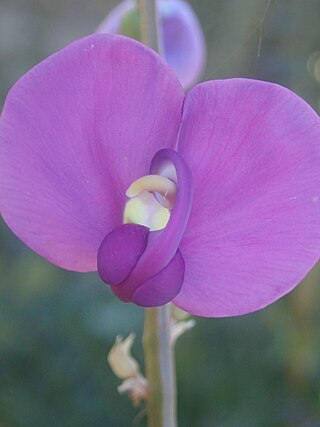
Swainsona procumbens is a plant in the pea family (Fabaceae) native to Australia and found in New South Wales, Victoria, Queensland and South Australia.
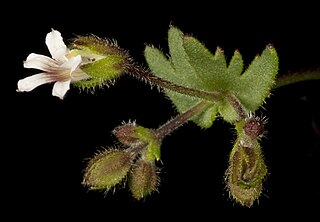
Goodenia cycnopotamica is a species of flowering plant in the Goodeniaceae family and is endemic to Australia, found in both South Australia and Western Australia. It is an annual herb with oblong to lance-shaped leaves and pink or lilac to white flowers.

Arabidella is a genus of flowering plants belonging to the family Brassicaceae. It was first described in 1853 by Ferdinand von Mueller as a subgenus of Erysimum to give the name, Erysimum subg. Arabidella, but was elevated to genus status by Otto Eugen Schulz in 1924. The type species is Arabidella trisecta.
Cuphonotus is a genus of flowering plants belonging to the family Brassicaceae.
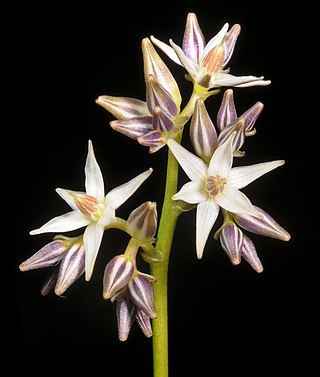
Phlebocarya filifolia is a plant in the Haemodoraceae family, native to Western Australia.

Macgregoria racemigera is a small plant in the family Celastraceae) found in inland Australia from New South Wales through Queensland, the Northern Territory to Western Australia, and South Australia.
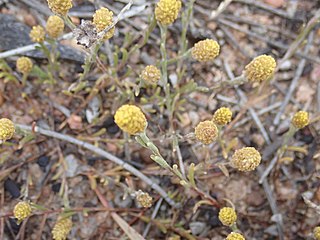
Calocephalus sonderi is a plant in the family Asteraceae, found in South Australia, Victoria, Queensland and New South Wales.

Styphelia allittii is a species of flowering plant in the family Ericaceae and is endemic to the south-west of Western Australia. It is a rigid, glabrous shrub that typically grows to a height of about 30 cm (12 in) and has egg-shaped or lance-shaped leaves and tube-shaped, white flowers.
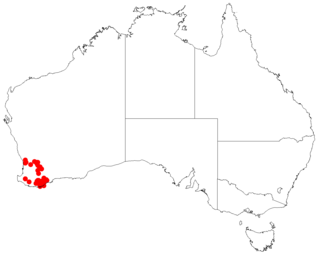
Styphelia cymbiformis is a flowering plant in the family Ericaceae and is endemic to the south-west of Western Australia. It is a bushy or wiry shrub that typically grows to a height of 30–50 cm (12–20 in) and has more or less glabrous branches. Its leaves are erect, linear to lance-shaped and sharply-pointed, mostly 2–4 mm (0.079–0.157 in) long. The flowers are arranged in short spikes, sometimes of only two or three flowers, with lance-shaped, leaf-like bracts, and bracteoles half as long as the sepals at the base of the spikes. The sepals are 2.5–3.0 mm (0.098–0.118 in) long and the petals slightly longer than the sepals, the lobes shorter than the petal tube.

Arabidella trisecta is a species of flowering plant belonging to the family Brassicaceae. It was first described in 1853 by Ferdinand von Mueller as Erysimum trisecta, but was transferred to the genus, Arabidella in 1924 when by Otto Eugen Schulz elevated Mueller's subgenus Arabidella to genus status. No type specimen was indicated by Mueller in 1853, and in 1965 Elizabeth A. Shaw specified the lectotype as MEL 758 and a paralectotype MEL 0000778A, both collected by Mueller from Spencers Gulf in South Australia.
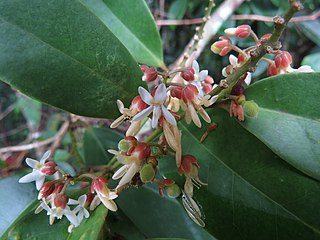
Xanthophyllum octandrum, commonly known as Macintyre's boxwood, false jitta, yellow boxwood or sovereignwood, is a slow-growing tree in the milkwort family Polygalaceae which has the potential to reach thousands of years of age. It is endemic to coastal northeastern Queensland, Australia.
Cuphonotus andraeanus is a species of plant in the Brassicaceae family, and was first described in 1885 by Ferdinand von Mueller as Capsella andraeana. It was reassigned to the genus, Cuphonotus, in 1974 by Elizabeth Anne Shaw.
















